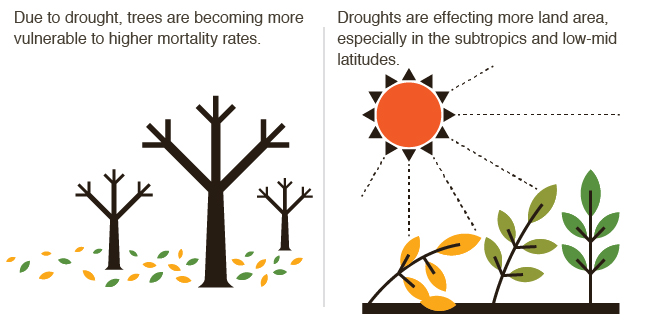Forests and Landscapes

Facts
- Climate change affects forests and their biodiversity by altering animal and plant reproduction, animal migration, length of the growing season, species distributions and population sizes and the frequency of pest and disease outbreaks (Root et al. 2003).
- Climate change is predicted to affect all aspects of biodiversity and ecosystem functioning in natural forests both directly (through temperature increases, precipitation changes, and sea-level changes and storm surges in coastal ecosystems) and indirectly (through changes in the intensity and frequency of wildfires and other disturbances) (Williams et al. 2008).
- Humid tropical mountain forests are particularly vulnerable to shifts in temperature and precipitation. In dry tropical forests, changes in rainfall and temperature can affect vegetation productivity and plant survival and make trees more susceptible to fire. The principal threat to tropical mangroves comes from sea-level rise and its consequences for sediment dynamics, erosion and salinity (Locatelli et al. 2010).
- Climate change is expected to affect survival, ranges, growth rates, yields, pests, diseases and pollination of trees on farms and in agroforestry systems (Thornton and Cramer 2012).
- Higher temperature can accelerate seed growth in some agroforestry species. Although climate change will likely accelerate tree growth, it is expected that it will also reduce the availability of plant nutrients, which would reduce productivity at the system level (Thornton and Cramer 2012).
- Climate change is expected to reduce winter chill in temperate regions. Winter chill is necessary to help temperate fruit trees overcome winter dormancy. Reduction of the winter-chill period, especially in warmer regions, might make current production areas unsuitable for currently grown species (Thornton and Cramer 2012).
Sources and further reading
- Easterling WE, Aggarwal PK, Batima P, Brander KM, Erda L, Howden SM, Kirilenko A, Morton J, Soussana J-F, Schmidhuber J, Tubiello FN. 2007. Food, fibre and forest products. In: Parry ML, Canziani OF, Palutikof JP, Van Der Linden PJ, Hanson CE, eds. Climate change 2007: Impacts, adaptation and vulnerability. Contribution of Working Group II to the fourth assessment report of the Intergovernmental Panel on Climate Change. Cambridge, UK: Cambridge University Press. pp. 273–313. (Available from https://www.ipcc.ch/pdf/assessment-report/ar4/wg2/ar4-wg2-chapter5.pdf)
- [FAO] Food and Agriculture Organization of the United Nations. 2013. Climate-smart agriculture sourcebook. Rome, Italy: Food and Agriculture Organization of the United Nations. (Available from http://www.fao.org/docrep/018/i3325e/i3325e.pdf) (Accessed 5 November 2013)
- Hyvönen R, Ågren GI, Linder S, Persson T, Cotrufo MF, Ekblad A, Freeman M, Grelle A, Janssens IA, Jarvis PG, Kellomäki S, Lindroth A, Loustau D, Lundmark T, Norby RJ, Oren R, Pilegaard K, Ryan MG, Sigurdsson BD, Strömgren M, van Oijen M, Wallin G. 2007. The likely impact of elevated [CO2], nitrogen deposition, increased temperature and management on carbon sequestration in temperate and boreal forest ecosystems: a literature review. New Phytologist 173(3):463–480. (Available from http://dx.doi.org/10.1111/j.1469-8137.2007.01967.x)
- Locatelli B, Brockhaus M, Buck A, Thompson I. 2010. Forests and adaptation to climate change: challenges and opportunities. In: Mery G, Katila P, Galloway G, Alfaro RI, Kanninen M, Lobovikov M, Varjo J, eds. Forests and Society: Responding to Global Drivers of Change. Vienna: IUFRO-WFSE. p. 21–42 (Available from http://www.iufro.org/science/special/wfse/forests-society-global-drivers/)
- Loo J, Fady B, Dawson I, Vinceti B, Baldinelli G. 2011. Climate change and forest genetic resources: State of knowledge, risks and opportunities. Prepared for the Thirteenth Regular Session of the Commission on Genetic Resources for Food and Agriculture, 18–22 July 2011, FAO Headquarters, Rome. Rome: Food and Agriculture Organization of the United Nations. (Available from http://www.fao.org/docrep/meeting/023/mb696e.PDF) (Accessed on 13 November 2013)
- Neufeldt H, Dawson IK, Luedeling E, Ajayi OC, Breedy T, Gebrekirstos A, Jamnadass TH, König K, Sileshi GW, Simelton E, Sotelo Montes C, Weber JC. 2010. Climate change vulnerability of agroforestry. Working paper. Nairobi: World Agroforestry Centre. (Available from http://www.worldagroforestry.org/downloads/publications/PDFS/WP12013.PDF) (Accessed on 13 November 2013)
- Root TL, Price JT, Hall KR, Schneider SH, Rosenzweig C, Pounds JA. 2003. Fingerprints of global warming on wild animals and plants. Nature 421:57–60. (Available from http://dx.doi.org/10.1038/nature01333)
- Shackleton S, Shackleton C, Shanley P, eds. 2011. Non-timber forest products in the global context. Tropical Forestry Volume 7. Springer.
- Thornton P, Cramer L, eds. 2012. Impacts of climate change on the agricultural and aquatic systems and natural resources within the CGIAR’s mandate. CCAFS Working Paper 23. Copenhagen: CGIAR Research Program on Climate Change, Agriculture and Food Security (CCAFS). (Available from http://cgspace.cgiar.org/handle/10568/21226) (Accessed 5 November 2013)
- Williams SE, Shoo LP, Isaac JL, Hoffmann AA, Langham G. 2008. Towards an integrated framework for assessing the vulnerability of species to climate change. PLoS Biology 6:2621–2626. (Available from http://dx.doi.org/10.1371/journal.pbio.0060325)